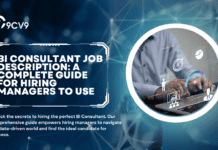Key Takeaways
- The CISO role requires a blend of technical expertise, leadership skills, and strategic business acumen, with a strong focus on risk management.
- Salary benchmarks for CISOs vary globally, with high demand in large organizations and industries like technology and finance offering the best compensation.
- Future CISOs will need to adapt to emerging trends like AI integration, Zero Trust architecture, and expanding responsibilities in data privacy and fraud prevention.
In today’s digital-first world, cybersecurity is no longer a luxury—it’s a necessity. As cyber threats grow more sophisticated and data breaches more frequent, organizations across the globe are turning to highly skilled security leaders to safeguard their critical information systems and infrastructure. At the forefront of this strategic defense is the Chief Information Security Officer (CISO)—a key executive role responsible for establishing and maintaining the enterprise vision, strategy, and program to ensure information assets and technologies are adequately protected. The rise of the CISO reflects a broader trend: the increasing integration of cybersecurity leadership within the highest levels of corporate governance. This blog presents a comprehensive analysis of the CISO career path, delving into its responsibilities, required qualifications, salary trends, skillsets, and future growth potential.

The evolution of the CISO role over the last two decades has been remarkable. Once a position largely confined to IT departments, the modern-day CISO now operates at the intersection of technology, risk management, regulatory compliance, and executive decision-making. With data privacy regulations such as GDPR, CCPA, and other national standards gaining prominence, the need for robust cybersecurity governance has surged. CISOs are now expected to report directly to the CEO or board of directors, playing a strategic role in shaping company-wide policies that align cybersecurity with broader business objectives.
For aspiring professionals and seasoned IT leaders looking to ascend into this role, understanding the CISO career trajectory is critical. The path to becoming a CISO typically involves years of hands-on experience in IT security, risk management, and leadership, often complemented by advanced education and certifications. As the digital landscape continues to evolve—driven by emerging technologies like cloud computing, AI, IoT, and blockchain—the role of the CISO is expanding, requiring continuous upskilling and adaptation to new threat vectors.
Moreover, the demand for CISOs is outpacing the supply of qualified candidates, making it one of the most lucrative and future-proof careers in the cybersecurity domain. According to global employment trends, enterprises ranging from Fortune 500 corporations to government agencies and mid-sized tech startups are actively recruiting CISOs to safeguard digital assets, maintain customer trust, and comply with complex regulatory frameworks. This growing demand has significantly influenced compensation benchmarks, with CISO salaries reaching new heights across various regions and industries.
This blog will serve as a detailed roadmap for navigating the CISO career path. Whether you’re a cybersecurity analyst aiming for executive leadership, a mid-level IT manager exploring strategic career options, or a student researching future opportunities in cybersecurity, this guide will offer deep insights into what it takes to become a successful Chief Information Security Officer. We will explore the essential qualifications, key responsibilities, core competencies, career milestones, and the most respected certifications in the field. Additionally, we’ll examine global salary benchmarks, industry-specific trends, and the future outlook for the CISO profession.
In the sections that follow, we’ll break down the CISO journey step-by-step, highlighting practical advice, real-world examples, and actionable tips to help you understand and navigate the complex but rewarding path to cybersecurity leadership. As cyber threats continue to pose existential risks to businesses and society, the importance of effective information security leadership has never been clearer. By understanding the CISO career path in depth, you can position yourself at the forefront of one of the most critical roles in the digital age.
Are you ready to explore what it takes to become a CISO and why this role is indispensable in today’s digital economy? Let’s dive into the world of information security leadership.
Before we venture further into this article, we would like to share who we are and what we do.
About 9cv9
9cv9 is a business tech startup based in Singapore and Asia, with a strong presence all over the world.
With over nine years of startup and business experience, and being highly involved in connecting with thousands of companies and startups, the 9cv9 team has listed some important learning points in this overview of the Chief Information Security Officer Career Path.
If your company needs recruitment and headhunting services to hire top-quality employees, you can use 9cv9 headhunting and recruitment services to hire top talents and candidates. Find out more here, or send over an email to [email protected].
Or just post 1 free job posting here at 9cv9 Hiring Portal in under 10 minutes.
Chief Information Security Officer Career Path: A Comprehensive Analysis
- Role Definition and Strategic Evolution
- The Chief Information Security Officer (CISO) Career Path in 2025: An Advanced Overview
- Navigating the CISO Interview Process in 2025: Key Insights and Strategic Preparation
- Charting the Chief Information Security Officer (CISO) Career Path in 2025
- Chief Information Security Officer (CISO) Compensation & Salary Trends in 2025
- The Future of the Chief Information Security Officer (CISO) Career Path in 2025
1. Role Definition and Strategic Evolution
In an increasingly interconnected global economy, cybersecurity has emerged as a critical function across all industries. Among the most pivotal roles in this domain is that of the Chief Information Security Officer (CISO)—a senior executive entrusted with the responsibility of safeguarding an organization’s digital assets, managing cyber risks, and ensuring resilience against a rapidly evolving threat landscape. In 2025, the scope, expectations, and strategic relevance of the CISO have dramatically expanded, positioning the role as a cornerstone of enterprise leadership.
Defining the CISO Role and Core Responsibilities in 2025
The modern CISO is no longer confined to the technical trenches of information technology. Instead, this role has evolved into a strategic executive position that bridges the gap between cybersecurity operations and enterprise-level decision-making.
Key Duties and Strategic Mandate
- Cybersecurity Program Design:
- Develops and leads enterprise-wide security frameworks.
- Ensures resilience against advanced persistent threats (APTs), ransomware, phishing, and zero-day exploits.
- Regulatory Compliance & Legal Alignment:
- Maintains adherence to global and regional regulations such as:
- GDPR (EU), CCPA (California), HIPAA (US healthcare), and PCI-DSS (financial transactions).
- Implements controls aligned with ISO/IEC 27001, NIST Cybersecurity Framework, and COBIT standards.
- Maintains adherence to global and regional regulations such as:
- Risk Management Oversight:
- Proactively assesses and manages cyber risk across all business functions.
- Aligns risk controls with enterprise risk appetite and board-level reporting structures.
- Security Architecture & Incident Response:
- Oversees network security design, application security, cloud security, and DevSecOps integration.
- Leads breach response teams and formulates recovery strategies.
Strategic Value of the CISO
- Integral to digital transformation initiatives and business continuity planning.
- Ensures secure innovation by embedding cybersecurity into product and service development lifecycles.
- Collaborates cross-functionally with legal, compliance, IT, finance, and HR departments.
Differentiating the CISO from Related Executive Roles
Understanding how the CISO compares to adjacent C-suite positions is vital for defining organizational security governance.
| Role | Focus Area | Scope | Key Distinctions |
|---|---|---|---|
| CISO | Cybersecurity | Digital asset protection, threat response, compliance | Specializes in managing information security and cyber risk |
| CIO | Information Technology | IT infrastructure, software systems, digital innovation | Drives IT strategy and digital business transformation |
| CSO | Corporate Security | Physical, operational, and cybersecurity | Broader security responsibilities beyond IT (e.g., facility and personnel protection) |
| CPO | Data Privacy | Regulatory data compliance, user consent | Focused on data protection and privacy rights, especially for end users |
The Expanding Scope of the CISO Role in 2025
As cyber threats become more complex and interwoven with business operations, the CISO’s role is undergoing significant transformation in scope and influence.
Modern Responsibilities: Beyond Traditional Security
- Business Risk Translation:
- Interprets cyber risks in the context of financial, operational, and reputational impact.
- Advises the board on cost-benefit trade-offs for cybersecurity investments.
- Digital Transformation Stewardship:
- Leads secure implementation of cloud migrations, IoT integrations, and AI deployment.
- Ensures that cybersecurity is a foundational element of digital innovation.
- Data Governance and Privacy:
- Oversees enterprise data protection strategies.
- Works with Chief Privacy Officers to navigate complex regulatory environments.
- Cross-Domain Leadership:
- Takes part in managing third-party risks, supply chain security, and insider threat programs.
- Partners with physical security teams to develop unified threat management models.
Emerging Areas of Responsibility
According to Gartner, 45% of CISOs will have responsibilities outside of traditional cybersecurity functions by 2027. This trajectory is already visible in 2025.
- Artificial Intelligence Risk Governance
- Evaluates AI-powered tools for ethical and secure deployment.
- Prevents algorithmic bias, data poisoning, and adversarial machine learning attacks.
- Fraud Prevention & Cybercrime Intelligence
- Collaborates with financial crime and anti-fraud units to detect digital fraud schemes.
- Sustainability & ESG Reporting
- Integrates cyber risk metrics into broader Environmental, Social, and Governance (ESG) strategies.
- Operational Technology (OT) and Critical Infrastructure Security
- Protects industrial control systems, SCADA networks, and other mission-critical infrastructure from cyber threats.
Economic Impact and the Business Case for CISOs
The Financial Relevance of the CISO
- The average cost of a data breach reached $9.44 million in 2022, and this figure continues to climb annually.
- Investing in experienced CISOs significantly reduces breach likelihood and enhances post-incident recovery speed.
Global Salary Trends (2025 Projection)
| Region | Average CISO Salary (USD/year) | Growth from 2023 |
|---|---|---|
| United States | $240,000 – $400,000 | +18% |
| Europe (UK, Germany, France) | $180,000 – $300,000 | +15% |
| Middle East (UAE, KSA) | $160,000 – $280,000 | +20% |
| Asia-Pacific (Singapore, Australia) | $140,000 – $250,000 | +22% |
Why the CISO Role Is Central to the Future of Cybersecurity Leadership
In 2025 and beyond, the CISO is no longer a support function—it is a business-critical role that shapes the strategic direction of organizations across sectors.
Key Takeaways
- CISOs are now boardroom influencers, not just technical specialists.
- Their decisions directly impact brand reputation, investor trust, and business continuity.
- The increasing demand for qualified CISOs is outpacing supply, leading to elevated compensation and high-level recruitment from cross-industry talent pools.
- As cybersecurity converges with other domains such as AI, privacy, physical security, and ESG, the CISO’s role becomes more complex and indispensable.
2. The Chief Information Security Officer (CISO) Career Path in 2025: An Advanced Overview
The role of the Chief Information Security Officer (CISO) has grown into a mission-critical executive function in 2025, representing a pivotal position at the intersection of cybersecurity strategy, enterprise risk management, and digital resilience. As the cybersecurity landscape becomes increasingly complex, organizations demand CISOs with both deep technical acumen and strong strategic foresight.
Expanded Job Scope and Executive Responsibilities
The CISO in 2025 is no longer a purely technical role; it now demands a hybrid leadership profile, combining governance, operational management, and business strategy integration.
Core Responsibilities and Daily Functions
- Enterprise Cybersecurity Leadership
- Designs, implements, and updates a comprehensive security strategy aligned with business objectives.
- Ensures security initiatives are embedded across digital transformation efforts and new business models.
- Operational Oversight
- Leads a wide array of cybersecurity functions including security engineering, security operations centers (SOCs), threat intelligence, and vulnerability management.
- Monitors real-time network activity and detects anomalies using advanced SIEM platforms and AI-powered analytics.
- Incident Response and Business Continuity
- Oversees incident response planning, breach investigations, and forensic analysis.
- Develops and regularly tests disaster recovery and business continuity plans.
- Risk Management and Compliance
- Conducts regular enterprise risk assessments to identify threats and evaluate risk appetite.
- Ensures compliance with regulatory mandates such as GDPR, HIPAA, PCI-DSS, and SOX.
- Strategic Reporting and Governance
- Provides regular briefings to executive leadership and the board on cybersecurity posture, emerging risks, and security KPIs.
- Aligns security strategy with the broader risk management and corporate governance frameworks.
- Security Awareness and Culture Building
- Leads internal security training initiatives to enhance employee awareness and reduce insider threats.
- Cultivates a culture of security-conscious behavior across departments.
Organizational Functions and Teams Under CISO Oversight
The CISO supervises a multifaceted ecosystem of security units, each dedicated to safeguarding distinct areas of the organization’s infrastructure.
Typical Departments Reporting to the CISO
- Security Operations Center (SOC)
- Monitors and responds to real-time threats across the enterprise network.
- Governance, Risk, and Compliance (GRC)
- Manages internal controls, policy frameworks, and regulatory audits.
- Cloud and Application Security
- Ensures secure deployment of cloud-native platforms and SaaS integrations.
- Oversees DevSecOps practices throughout the software development lifecycle.
- Security Architecture and Engineering
- Designs and maintains the organization’s cybersecurity architecture.
- Evaluates and deploys next-gen firewalls, endpoint protection, and encryption tools.
- Threat Intelligence and Vulnerability Management
- Gathers insights on emerging threats from global feeds and dark web monitoring.
- Runs penetration tests and red team simulations.
- Product and Data Security
- Embeds privacy and security-by-design principles in product development.
- Business Information Security Officers (BISOs)
- Serve as liaisons between central cybersecurity leadership and individual business units.
Average Team Size
- In medium-to-large enterprises, CISOs typically manage:
- Direct reports: 5–10 senior managers or directors.
- Total cybersecurity workforce: 30–150+ personnel, depending on industry and regulatory exposure.
Upholding the CIA Triad: Confidentiality, Integrity, Availability
At the heart of every CISO’s strategy lies the preservation of the CIA Triad—a foundational framework for information security.
CISO Actions to Uphold the CIA Triad
- Confidentiality
- Implements access control mechanisms, data encryption, and DLP (Data Loss Prevention) tools.
- Enforces Zero Trust Architecture principles to reduce insider and external risks.
- Integrity
- Applies hashing, digital signatures, and blockchain validation for data verification.
- Establishes secure audit trails and ensures compliance with data integrity controls.
- Availability
- Ensures uptime and resiliency through redundant systems, real-time failover, and disaster recovery planning.
- Protects against DDoS attacks and system disruptions.
Insight: Every decision made by the CISO is fundamentally aligned with reinforcing these three pillars, ensuring organizational resilience and trust.
Security Strategy and Policy Development
In 2025, CISOs are expected to formulate dynamic security strategies that evolve in tandem with technological innovations and threat landscapes.
Strategic Initiatives Led by CISOs
- Security Policy Lifecycle Management
- Develops and enforces policies that govern user behavior, data handling, and third-party access.
- Integrates industry standards such as:
- NIST Cybersecurity Framework
- ISO/IEC 27001
- CIS Controls
- Program Roadmap Development
- Crafts multi-year information security roadmaps with clearly defined milestones.
- Aligns security initiatives with growth, M&A activities, and IT modernization.
- Stakeholder Engagement
- Facilitates workshops, tabletop exercises, and training with key business units.
- Bridges communication between technical teams and non-technical stakeholders.
Risk, Compliance, and Incident Management Excellence
Managing risk and regulatory compliance is a cornerstone of the modern CISO mandate.
Risk Governance Framework
- Conducts ongoing risk identification and quantification.
- Uses enterprise GRC platforms to manage regulatory obligations and automate control monitoring.
Incident Detection and Breach Response
- Implements 24/7 monitoring with threat intelligence feeds and SOC automation.
- Activates response playbooks for breaches involving ransomware, insider threats, or third-party exposures.
Legal and Disciplinary Coordination
- Leads investigations into data breaches and system compromises.
- Coordinates with legal, PR, and HR teams for public disclosures, regulatory reporting, and internal sanctions.
Comparative CISO Salary Outlook by Region (2025)
| Region | Average Annual Salary (USD) | Salary Trend (YoY Growth) |
|---|---|---|
| United States | $240,000 – $400,000 | ↑ 18% |
| United Kingdom | $180,000 – $310,000 | ↑ 16% |
| United Arab Emirates | $160,000 – $280,000 | ↑ 20% |
| Singapore | $150,000 – $270,000 | ↑ 22% |
| Australia | $140,000 – $260,000 | ↑ 17% |
Note: Compensation varies based on company size, industry (e.g., finance vs. healthcare), and regulatory exposure.
Final Insight: The Strategic Future of the CISO Role
The CISO’s responsibilities in 2025 are deeply integrated with enterprise strategy, digital innovation, and operational resilience. No longer confined to technical oversight, the CISO is now a strategic architect of trust and risk mitigation.
Why the CISO Role Is Indispensable
- Protects core business assets against a backdrop of rising nation-state cyber threats and AI-powered attacks.
- Ensures secure digital transformation, from cloud adoption to data-driven AI integration.
- Enhances corporate governance by embedding cybersecurity in ESG reporting, privacy frameworks, and boardroom risk oversight.
3. Navigating the CISO Interview Process in 2025: Key Insights and Strategic Preparation
The interview process for the role of Chief Information Security Officer (CISO) in 2025 reflects the multifaceted and executive nature of this position. With increasing cybersecurity threats and compliance mandates, organizations now seek CISOs who demonstrate a rare blend of technical expertise, strategic vision, business acumen, and leadership strength.
Common CISO Interview Questions: Strategic and Operational Focus
Recruiters and executive boards tailor CISO interviews to explore a candidate’s practical experience, judgment under pressure, and ability to align cybersecurity efforts with business goals.
Frequently Asked Interview Topics:
- Cybersecurity Strategy Development:
- Describe a time when you designed and executed an enterprise-wide cybersecurity strategy.
- How do you ensure security strategy aligns with the organization’s risk appetite and business priorities?
- Incident Management & Breach Response:
- Walk us through how you investigated and resolved a significant data breach.
- What is your protocol for managing post-breach communications and mitigation?
- Staying Current with Emerging Threats:
- How do you remain informed about rapidly evolving cybersecurity risks?
- What sources or tools do you rely on to anticipate new vulnerabilities?
- Governance and Conflict Resolution:
- How do you address disagreements between business leadership and the security function?
- Describe a situation where you had to defend a security initiative to skeptical stakeholders.
Insight: These questions aim to uncover the candidate’s depth of expertise in handling real-world security threats, capacity for strategic alignment, and ability to lead during crises.
Technical Interview Questions: Evaluating Cybersecurity Proficiency
Though the CISO role is increasingly strategic, a robust technical foundation is still essential to effectively supervise cybersecurity programs and communicate with technical teams.
Core Technical Areas Explored:
- Foundational Knowledge:
- What does SSL stand for and what is its significance in secure communications?
- Over which port does pinging operate, and why?
- Cloud Security Risks:
- What are the key challenges in securing cloud-native infrastructures?
- Describe your approach to multi-cloud or hybrid cloud environments.
- Security Patch Management:
- What procedures do you implement to ensure timely application of critical patches?
- Zero-Trust Architectures:
- Explain how you would implement a zero-trust model within a distributed enterprise.
Insight: These questions evaluate whether a CISO candidate can provide meaningful oversight, mentor engineering leaders, and confidently participate in security architecture discussions.
Strategic Interview Questions: Aligning Cybersecurity and Business Objectives
CISOs must now serve as both technical authorities and business enablers. Interviews test a candidate’s ability to formulate, communicate, and implement strategies that align with organizational goals.
Common Strategic Themes:
- Business-Centric Security Vision:
- How do you translate security goals into tangible business outcomes?
- Board-Level Communications:
- Describe your experience in presenting cybersecurity posture updates to the board of directors.
- How do you quantify and communicate cybersecurity ROI?
- Risk Quantification:
- How do you assess and determine acceptable levels of organizational risk?
- Security Roadmap Development:
- Outline how you’d develop a three- to five-year cybersecurity roadmap that scales with business growth.
Insight: Strategic questions assess a candidate’s future-readiness, financial literacy, and executive collaboration skills—essential for integrating cybersecurity into overall enterprise strategy.
Leadership Interview Questions: Executive Presence and Team Management
As executive leaders, CISOs are expected to cultivate high-performance security cultures while bridging cross-functional gaps.
Common Leadership Competencies Explored:
- Cybersecurity Team Leadership:
- What is your leadership style, and how have you built resilient security teams?
- Culture and Awareness:
- Describe your efforts to foster an organization-wide culture of cybersecurity awareness.
- Stakeholder Engagement:
- How do you manage relationships with IT, legal, finance, and other non-security departments?
- Mentorship and Talent Development:
- How have you developed the next generation of cybersecurity leaders?
Insight: Leadership-focused questions emphasize interpersonal intelligence, influence, and the ability to champion organizational change through effective communication.
Smart Questions CISO Candidates Should Ask Interviewers
Asking thoughtful questions is a powerful way for candidates to evaluate the organization’s cybersecurity maturity and leadership support.
Insightful Questions to Consider:
- Budget and Resource Allocation:
- What percentage of the IT budget is allocated to cybersecurity, and how is it determined?
- Reporting Structure:
- Does the CISO report directly to the CEO or board, or through another executive?
- Board Involvement in Cybersecurity:
- Is there dedicated cybersecurity expertise on the board of directors?
- Past Breach History:
- Has the company experienced any significant breaches in the past three years? How were they handled?
- Cybersecurity Team Dynamics:
- What is the current size and structure of the cybersecurity team? What challenges are they facing?
Insight: Asking these questions helps CISO candidates assess not just the role’s scope but also the level of institutional support and maturity of the security function.
Comparative Table: Types of CISO Interview Questions and Evaluation Focus
| Interview Question Category | Purpose | Key Evaluation Areas |
|---|---|---|
| Strategic Questions | Assess alignment with business strategy | Vision, board communication, ROI articulation |
| Technical Questions | Evaluate cybersecurity expertise | Architecture, cloud, risk response, zero trust |
| Leadership Questions | Understand management and influence | Team development, executive presence, culture |
| Scenario-Based Questions | Test problem-solving and adaptability | Crisis handling, real-life breach resolution |
| Candidate’s Questions | Reflect engagement and due diligence | Organizational maturity, team structure, support |
Final Insight: Preparing for the CISO Role in 2025
The evolving threat landscape in 2025 has transformed the CISO into a strategic, board-facing executive role. The interview process is now designed to explore a candidate’s technical depth, strategic vision, leadership ability, and business fluency. Mastery of these dimensions is no longer optional—it is a prerequisite for securing this pivotal position in any modern enterprise.
4. Charting the Chief Information Security Officer (CISO) Career Path in 2025
In 2025, the path to becoming a Chief Information Security Officer (CISO) has evolved into a highly dynamic and strategic career journey. No longer confined to a purely technical domain, the CISO role now sits at the intersection of cybersecurity leadership, enterprise risk management, and executive decision-making. Aspiring professionals must navigate a career trajectory that blends deep technical expertise with strategic foresight and organizational leadership.
Career Progression: From Technical Expertise to Executive Leadership
The trajectory toward the CISO role is typically non-linear and varies based on individual experience, industry demands, and organizational size. However, several common career pathways have emerged across the industry.
Common Pre-CISO Roles and Career Stages:
- Technical Foundation Roles:
- Security Analyst: Initial exposure to threat detection, incident response, and risk assessments.
- Network Engineer / Systems Administrator: Foundational roles that build expertise in securing enterprise networks and IT infrastructure.
- Mid-Level Management Roles:
- Security Operations Center (SOC) Manager: Leadership in operational security environments.
- Information Security Manager or Director: Focus on governance, policy development, and high-level strategy.
- Adjacent Executive Pathways:
- Chief Technology Officer (CTO) or Chief Information Officer (CIO): Some CISOs transition laterally from these executive roles, leveraging strategic leadership experience.
- GRC Professionals (Governance, Risk, and Compliance): Professionals with audit, compliance, or legal expertise increasingly rise to CISO roles due to the critical importance of risk and regulatory alignment.
- Cross-Functional Experience:
- Professionals with exposure to legal, regulatory, or business continuity functions often contribute unique perspectives highly valued in modern CISO responsibilities.
Insight: A successful path to the CISO position is often marked by progressive technical experience, cross-functional collaboration, and a clear transition into strategic and leadership roles.
Educational Requirements and Professional Certifications
In 2025, educational credentials and certifications play a pivotal role in validating a candidate’s qualifications for CISO roles. These credentials signal both technical competence and a commitment to lifelong professional development.
Academic Foundations:
- Bachelor’s Degree:
- Common fields include:
- Cybersecurity
- Information Technology
- Computer Science
- Network Engineering
- Common fields include:
- Master’s Degree (Preferred by Many Enterprises):
- Advanced degrees in:
- Cybersecurity
- Information Assurance
- Business Administration (MBA)
- Technology Management
- Advanced degrees in:
In-Demand Cybersecurity Certifications:
| Certification | Full Name | Focus Area |
|---|---|---|
| CISSP | Certified Information Systems Security Professional | Enterprise security leadership and risk management |
| CISM | Certified Information Security Manager | Governance, incident response, and program development |
| CCISO | Certified Chief Information Security Officer | Executive-level strategy, budgeting, and compliance |
| CRISC | Certified in Risk and Information Systems Control | IT risk identification and control implementation |
| CEH | Certified Ethical Hacker | Offensive security and penetration testing |
Insight: Holding multiple, high-level certifications significantly boosts a candidate’s marketability, especially when combined with relevant academic qualifications and applied experience.
Experience Requirements: Building a Decade of Progressive Competence
Achieving the CISO title generally requires a robust and extensive background in cybersecurity, often spanning over a decade. Employers emphasize not only technical tenure but also leadership maturity and enterprise-wide impact.
Typical Experience Benchmarks:
- Total Information Security Experience:
- Most CISO candidates possess 8 to 12 years of cybersecurity experience.
- Of these, 5+ years are often in senior or managerial positions.
- Leadership and People Management:
- Minimum 3 to 5 years of experience managing cross-functional security teams or departments.
- Cumulative IT Exposure:
- Broader 10+ years in IT roles (across operations, infrastructure, cloud, etc.) is common, reflecting interdisciplinary expertise.
- Crisis and Incident Management:
- Proven track record of responding to and managing high-severity security incidents is increasingly critical.
Insight: Candidates with a history of increasing responsibility, measurable business impact, and demonstrated thought leadership are best positioned to ascend to the CISO level.
CISO Career Path Timeline: Typical Progression by Years of Experience
| Years of Experience | Typical Roles | Career Focus |
|---|---|---|
| 0–3 Years | Security Analyst, IT Technician | Technical learning, foundational skills |
| 3–6 Years | Systems Engineer, Network Security Specialist | Implementation, monitoring, and analysis |
| 6–9 Years | SOC Manager, Security Architect | Tactical leadership, solution design |
| 9–12 Years | Director of Security, GRC Manager | Strategic oversight, risk management |
| 12+ Years | CISO, VP of Information Security | Executive leadership, board-level reporting |
Summary: Building a Successful CISO Career in 2025
To secure a Chief Information Security Officer position in today’s complex threat landscape, professionals must strategically develop across three critical dimensions: technical mastery, leadership capability, and business integration.
Key Takeaways for Aspiring CISOs:
- No single pathway guarantees success—technical specialists, governance professionals, and even former CIOs may all rise to the CISO role.
- Formal education and certifications are necessary but must be complemented by real-world experience and operational maturity.
- A decade or more of experience—including both technical and leadership roles—is typically required to be considered for a CISO role in top-tier organizations.
- Strategic communication and board engagement skills are now non-negotiable competencies for CISOs in 2025.
5. Chief Information Security Officer (CISO) Compensation & Salary Trends in 2025
In 2025, the role of the Chief Information Security Officer (CISO) has not only become mission-critical to organizational risk strategy but also one of the most well-compensated executive positions in the corporate hierarchy. Compensation benchmarks have escalated globally in response to increasing cybersecurity threats, regulatory scrutiny, and board-level accountability.
CISO Salary Benchmarks: Global Comparisons and Country-Specific Insights
United States Salary Overview:
- Average Base Salary (May 2025):
- Approx. $240,759 per year
- Typical Range: $205,488 – $291,812 annually
- Entry-Level Salary (0–2 years in role):
- Estimated around $231,115 annually
- Senior-Level Salary (8+ years in role):
- Reaches or exceeds $240,000 annually, with some cases surpassing $500,000 in total compensation
Vietnam Salary Overview:
- Average Gross Salary:
- ₫1,123,369,521 VND/year (~$44,000 USD)
- Entry-Level CISO (1–3 years):
- Approx. ₫788,644,181 VND/year
- Senior-Level CISO (8+ years):
- Approx. ₫1,419,559,526 VND/year
Insight: CISOs in the United States command significantly higher compensation compared to their counterparts in emerging markets such as Vietnam. This disparity is largely driven by differences in economic structure, cost of living, market maturity, and the scale of cybersecurity investment.
CISO Salary Breakdown by Company Size and Industry (U.S. Focus)
The salary scale for CISOs in the United States fluctuates based on organization size, sector, and the complexity of cybersecurity operations.
Salary by Company Size:
| Company Size | Average Annual Salary |
|---|---|
| Small Enterprises | ~$235,000 |
| Mid-Sized Organizations | ~$250,000 |
| Large Enterprises | ~$267,000+ |
Salary by Industry:
| Industry | Total Compensation (Base + Equity + Bonus) |
|---|---|
| Technology (Big Tech, SaaS) | ~$721,000 |
| Financial Services | ~$705,000 |
| Healthcare & Pharma | ~$610,000 |
| Retail & eCommerce | ~$560,000 |
| Manufacturing & Industrial | ~$510,000 |
Insight: Large enterprises and high-risk sectors such as finance and technology offer the most lucrative compensation structures, often including equity and performance-linked bonuses.
CISO Experience Level vs. Salary Progression
A key determinant in a CISO’s earning potential is cumulative experience, both in cybersecurity and in leadership roles.
| Experience Level | U.S. Average Base Salary | Vietnam Average (VND) |
|---|---|---|
| Entry-Level (1–3 years) | ~$231,115 | ₫788,644,181 (~$30K–$35K) |
| Mid-Level (4–7 years) | ~$240,000 | ₫1,100,000,000 (~$43K–$45K) |
| Senior-Level (8+ years) | $240,759 – $500,000+ | ₫1,419,559,526 (~$55K–$60K) |
| Top-Tier (15+ years, C-suite) | $500,000 – $1,000,000+ | Typically not reported |
Insight: Experience serves as a powerful salary accelerator. While early-career CISOs earn respectable figures, compensation scales significantly for those with over a decade in cybersecurity leadership.
Comprehensive Compensation Packages: Beyond Base Salary
Modern CISO compensation packages go far beyond fixed salaries, incorporating a range of benefits aligned with the strategic weight of the role.
Common Components of CISO Compensation in 2025:
- Performance Bonuses:
- Frequently tied to incident prevention, audit outcomes, or regulatory compliance metrics
- Equity Participation:
- Especially prevalent in technology startups and IPO-track companies
- Equity Stakes: Typically range from 0.3% to 2%, depending on funding stage
- Sign-On Bonuses:
- Often six-figure amounts, particularly in competitive industries
- Directors & Officers (D&O) Insurance:
- Increasingly standard to shield CISOs from personal liability due to regulatory action or data breaches
- Long-Term Incentive Plans (LTIPs):
- Multi-year stock grants or cash-based retention bonuses
Insight: As cybersecurity becomes central to corporate sustainability, organizations are enhancing compensation with risk-aligned benefits that reflect the legal, financial, and operational responsibilities shouldered by CISOs.
Future Outlook: Compensation Trends in 2025 and Beyond
The demand for experienced CISOs continues to rise, influenced by escalating cyber threats, AI-integrated attack vectors, and tightening global data protection regulations (such as GDPR, HIPAA, and SEC cyber disclosures). These trends are directly impacting compensation dynamics:
Projected Trends:
- Sustained Growth in Total Compensation:
- Average total pay packages projected to exceed $600,000 in Fortune 500 firms
- Increase in Cross-Border Hiring:
- U.S. companies hiring CISOs remotely from regions like India and Eastern Europe, potentially creating new global compensation tiers
- Premium for Specialized Skills:
- CISOs with expertise in cloud security, AI-driven threat intelligence, or zero trust architecture will command premium salaries
Insight: The evolving threat landscape and regulatory environment will continue to drive compensation upward, with greater complexity in package design to attract top-tier cybersecurity talent.
Final Thoughts: Positioning for High-Value CISO Roles
The role of a CISO in 2025 is no longer limited to overseeing security operations; it now entails executive-level risk governance, enterprise-wide resilience planning, and strategic innovation in cybersecurity frameworks.
Key Takeaways:
- U.S. CISOs command the highest global compensation, with total packages often exceeding $500K annually.
- Industry, company size, and geographic region significantly influence pay scales.
- Equity, bonuses, and legal protections are becoming standard features in CISO contracts.
- Experience and specialization are the most impactful factors for achieving top-tier compensation.
6. The Future of the Chief Information Security Officer (CISO) Career Path in 2025
The evolving threat landscape, technological advancements, and growing regulatory demands are redefining the role of Chief Information Security Officers (CISOs) in 2025. This transformation has significant implications for job outlook, skills requirements, organizational influence, and the responsibilities CISOs are expected to carry.
Rising Demand and Employment Projections for CISOs
- Sustained Market Growth
- The U.S. Bureau of Labor Statistics forecasts a 17% growth rate for computer and information systems managers, including CISOs, between 2023 and 2033.
- This growth rate is significantly faster than the national average for all occupations, indicating robust demand.
- Global Executive Presence
- By 2023, there were approximately 32,000 CISOs globally, according to Cybersecurity Ventures.
- As of 2022, every Fortune 500 company had formally appointed a CISO or an equivalent security executive.
- Market Stabilization Trends
- IANS Research and Artico Search reported in 2024 that CISO hiring began to stabilize, with reduced turnover indicating organizational efforts to retain talent and build continuity.
Insight: The demand for experienced CISOs continues to be driven by the increasing complexity of cyber threats. Although recent trends suggest a stabilization in hiring, the strategic importance of the CISO role is firmly established across sectors.
Core Competencies and Emerging Skillsets for Future CISOs
- Technical Mastery
- Deep knowledge of cybersecurity principles, threat detection, vulnerability management, and secure system architecture remains critical.
- Familiarity with cloud-native security, AI-driven threat intelligence, and endpoint detection is increasingly essential.
- Soft Skills and Leadership Attributes
- Strong interpersonal skills, particularly communication and conflict resolution, are key for interdepartmental collaboration.
- Leadership capability to influence C-level executives and drive a security-first culture across diverse business units.
- Business Acumen and Risk Communication
- Ability to frame cybersecurity issues in business terms for executive stakeholders.
- Expertise in risk quantification, financial forecasting of cyber incidents, and security ROI analysis.
- Compliance and Regulatory Insight
- Proficiency in global data privacy laws (e.g., GDPR, CCPA), and compliance frameworks (e.g., ISO 27001, NIST CSF).
- Capability to anticipate legal developments and proactively update compliance strategies.
Insight: The future CISO must be more than a security expert—they must be a strategic business leader capable of aligning cybersecurity initiatives with enterprise goals.
Evolving Organizational Structures and CISO Influence
- Reporting Hierarchy Shifts
- In 2024, 14% of CISOs reported directly to the CEO, a notable increase from 5% in 2023.
- This shift signifies the recognition of cybersecurity as a board-level issue, not just an IT function.
- Board-Level Engagement
- Many CISOs now present regularly to the board—monthly or quarterly—demonstrating their role in enterprise strategy.
- Increased transparency with board members about cyber risk posture and investment needs.
- Cultural Transformation
- CISOs are expected to drive security awareness across departments and embed risk considerations into day-to-day operations.
Insight: The CISO’s role is becoming increasingly strategic, characterized by greater autonomy, executive visibility, and influence over enterprise-wide decision-making.
Expansion of Responsibilities and Industry Trends
- Regulatory Pressure and Personal Liability
- New regulations have elevated the legal accountability of CISOs, especially concerning breach notification timelines and data handling.
- Technological Disruption
- Greater integration of Artificial Intelligence and machine learning into security tools for predictive threat modeling.
- Widespread adoption of Zero Trust frameworks that enforce strict identity and access controls.
- Broader Remit Beyond Cybersecurity
- CISOs are assuming roles in data privacy management, fraud prevention, and in some cases, overseeing physical security.
- Gartner predicts that by 2027, nearly 50% of CISOs will have non-traditional security responsibilities.
Insight: The CISO’s responsibilities are rapidly diversifying, demanding a broader knowledge base, legal awareness, and multidisciplinary coordination skills.
Job Satisfaction, Stress Levels, and Tenure Dynamics
- Average Tenure Overview
- CISOs typically remain in a role for 18 to 36 months.
- Among Fortune 500 companies, the average tenure is slightly higher at approximately 4.5 years.
- Key Sources of Burnout
- 80% of CISOs report inadequate cybersecurity budgets.
- Persistent stress related to high-stakes decision-making, talent shortages, and regulatory pressure.
- Factors Influencing Job Satisfaction
- High engagement with top leadership significantly enhances job satisfaction.
- Organizations that empower CISOs with decision-making authority and adequate resources are more likely to retain them long term.
Insight: Despite lucrative compensation, the CISO role is high-pressure and prone to burnout. Companies must address resourcing and leadership alignment to support sustainable cybersecurity leadership.
Table: CISO Career Landscape Snapshot (2025)
| Aspect | Data/Insight |
|---|---|
| Global CISO Count (2023) | ~32,000 |
| U.S. Job Growth (2023–2033) | 17% (BLS) |
| Fortune 500 CISO Adoption | 100% by 2022 |
| Direct CEO Reporting (2024) | 14% (up from 5% in 2023) |
| Typical Tenure | 18–36 months; ~4.5 years in Fortune 500 |
| Burnout Factors | Inadequate budgets, high stress, talent gaps |
| Emerging Responsibilities | Data privacy, fraud prevention, physical security |
Chart: Key Future Skills for CISOs (2025 and Beyond)
Skillset Breakdown:
| Skill Area | Relative Importance (%) |
|------------------------------|--------------------------|
| Technical Security Knowledge | 90% |
| Communication & Leadership | 85% |
| Regulatory & Legal Expertise | 75% |
| AI & Emerging Tech Literacy | 70% |
| Business Risk Translation | 80% |Conclusion: The Chief Information Security Officer role in 2025 is more strategic, visible, and multifaceted than ever before. As the digital threat landscape intensifies and corporate governance shifts, CISOs are positioned as critical executive leaders. Success in this career path will depend on a balance of technical prowess, business insight, and adaptive leadership in a high-stakes, ever-evolving domain.
Conclusion
The Chief Information Security Officer (CISO) career path in 2025 reflects a rapidly evolving blend of technical mastery, executive leadership, strategic foresight, and regulatory acumen. As cyber threats grow increasingly sophisticated and digital infrastructures become more complex, the importance of robust cybersecurity leadership at the executive level cannot be overstated. The CISO is no longer a back-office technologist but a boardroom influencer, driving organizational resilience, digital trust, and business continuity across every industry vertical.
This comprehensive analysis of the CISO career path demonstrates that achieving this prestigious role requires a multifaceted and deliberate approach. Candidates must invest in building a deep technical foundation early in their careers—often through roles such as security analyst, network engineer, or systems architect—while simultaneously developing the leadership capabilities and business acumen needed to navigate corporate environments and influence decision-making at the highest levels.
Over time, successful CISOs cultivate a hybrid skill set that includes:
- Expertise in risk management and regulatory compliance frameworks like NIST, ISO 27001, GDPR, and industry-specific standards.
- Fluency in cyber governance, digital forensics, and threat intelligence—not just understanding the technology but aligning it with enterprise goals.
- Proven leadership and communication skills, allowing them to articulate complex cybersecurity issues to non-technical stakeholders and executive boards.
- Continuous learning and adaptability, particularly in areas such as artificial intelligence, zero-trust architecture, cloud security, and data privacy.
In terms of educational and credentialing benchmarks, the modern CISO is typically supported by a bachelor’s or master’s degree in cybersecurity, information technology, or business administration, supplemented with leading certifications such as CISSP, CISM, and CCISO. Employers place significant value on professional experience, often requiring 8 to 10+ years in progressively responsible roles, with at least five years in direct leadership positions.
Salary benchmarks also reflect the strategic weight of the CISO position. In 2025, CISO compensation packages are becoming more comprehensive and competitive, with total rewards often exceeding $500,000 annually in the United States—particularly in the tech and financial sectors. These packages increasingly include equity, performance bonuses, and even liability protections such as D&O insurance, underscoring the critical and high-risk nature of the role.
Looking ahead, several important trends will continue to shape the CISO profession:
- Elevated organizational influence: More CISOs are reporting directly to CEOs or boards of directors, highlighting their role in strategic risk mitigation.
- Expanded scope of responsibility: The CISO’s role is broadening beyond cybersecurity to include data governance, fraud prevention, and physical security.
- Increased regulatory scrutiny and personal accountability, requiring a robust understanding of legal obligations and incident disclosure laws.
- Talent challenges and burnout risks, which may limit tenure and pose long-term recruitment difficulties unless organizations address resource and support needs proactively.
Despite the pressures, the role remains highly fulfilling for professionals who are motivated by protecting digital assets, guiding enterprise-wide security transformation, and leading organizational responses to global cyber threats. With rising digital interconnectivity, geopolitical tensions, and advanced persistent threats (APTs), the role of the CISO is expected to become even more central in enterprise strategy and governance.
In conclusion, the Chief Information Security Officer career path is a dynamic and high-stakes executive journey that combines deep technical expertise with visionary leadership. For aspiring cybersecurity professionals in 2025, the road to becoming a CISO offers not only financial reward and career prestige but also the opportunity to make a significant and lasting impact on the digital future of their organizations. By staying current with industry trends, continuously expanding their skill set, and strategically navigating their career development, future CISOs will be well-positioned to lead the charge in securing tomorrow’s digital enterprises.
If you find this article useful, why not share it with your hiring manager and C-level suite friends and also leave a nice comment below?
We, at the 9cv9 Research Team, strive to bring the latest and most meaningful data, guides, and statistics to your doorstep.
To get access to top-quality guides, click over to 9cv9 Blog.
People Also Ask
What is the role of a Chief Information Security Officer (CISO)?
The CISO is responsible for overseeing an organization’s cybersecurity strategy, including risk management, compliance, and incident response. They ensure the safety of data, systems, and networks while aligning security goals with business objectives.
What qualifications are needed to become a CISO?
To become a CISO, candidates typically need a bachelor’s degree in cybersecurity, IT, or a related field, along with certifications such as CISSP, CISM, or CCISO. Advanced degrees and extensive experience in leadership and security roles are also beneficial.
How long does it take to become a CISO?
Becoming a CISO generally requires 10-15 years of experience in information security, including technical roles and leadership positions. The timeline varies based on individual career paths, education, and organizational opportunities.
What skills are required for a CISO in 2025?
A CISO must have strong technical skills in cybersecurity, leadership, strategic thinking, and risk management. Soft skills, like communication, collaboration, and adaptability, are also crucial as the role continues to evolve.
What is the average salary for a CISO in 2025?
In 2025, the average salary for a CISO in the US is approximately $240,000 annually, but it can range from $205,000 to $292,000, depending on the organization’s size, industry, and location.
What factors influence a CISO’s salary?
Factors influencing a CISO’s salary include company size, industry, experience level, geographic location, and the specific responsibilities associated with the role. Larger companies and tech industries tend to offer higher compensation packages.
What are the career advancement opportunities for a CISO?
CISOs can progress to other executive positions such as Chief Technology Officer (CTO) or Chief Operating Officer (COO), particularly in organizations where cybersecurity is a key business driver. There are also opportunities in advisory roles or starting a cybersecurity consultancy.
Is the CISO role in high demand?
Yes, the demand for CISOs is growing due to the increasing complexity of cyber threats and the critical need for robust cybersecurity leadership. According to projections, the demand for CISOs is expected to grow faster than the average job market.
What industries hire CISOs?
CISOs are in demand across various industries, including finance, healthcare, technology, government, and manufacturing. Any organization handling sensitive data or at risk of cyber threats needs a dedicated CISO.
What certifications are beneficial for aspiring CISOs?
Certifications such as CISSP (Certified Information Systems Security Professional), CISM (Certified Information Security Manager), and CCISO (Certified Chief Information Security Officer) are highly valued by employers when hiring a CISO.
What are the most common challenges faced by CISOs?
CISOs face challenges such as managing complex security infrastructures, keeping up with evolving cyber threats, ensuring compliance with regulations, securing budgets for security initiatives, and mitigating organizational risks.
What is the job outlook for CISOs in the next decade?
The job outlook for CISOs remains strong due to the constant evolution of cyber threats. With an increasing focus on data protection and regulatory compliance, the need for skilled cybersecurity leaders will continue to grow.
How does a CISO contribute to an organization’s strategic goals?
A CISO contributes by aligning cybersecurity initiatives with business goals, mitigating risks, ensuring compliance with regulations, and protecting the organization’s assets and reputation. They play a key role in shaping the company’s security culture.
Can a CISO transition from other IT roles?
Yes, many CISOs transition from roles such as network administrator, systems engineer, or IT director. A strong technical background and leadership experience in IT are valuable assets when moving into a CISO role.
What are the primary responsibilities of a CISO?
A CISO is responsible for creating and implementing cybersecurity policies, managing security teams, ensuring compliance with legal and regulatory standards, and developing incident response plans to address potential data breaches or cyberattacks.
What is the average tenure of a CISO?
The average tenure of a CISO typically ranges between 2 to 4 years. Factors like job stress, organizational change, and evolving security needs contribute to a higher turnover rate compared to other executive positions.
How can a CISO stay updated on cybersecurity trends?
CISOs can stay updated by attending industry conferences, joining professional organizations, pursuing continuous education and certifications, and keeping up with the latest research on cybersecurity tools, practices, and threat intelligence.
What is the career path for a CISO?
The career path to becoming a CISO usually starts with technical roles in information security, followed by positions like Security Manager or Director of Information Security. After gaining leadership experience, professionals can advance to the CISO role.
What is the difference between a CISO and a CIO?
A Chief Information Officer (CIO) focuses on managing the company’s IT infrastructure and technology strategy, while a CISO is specifically responsible for the organization’s cybersecurity and information security policies.
Do CISOs need to have a background in IT?
While it’s not strictly required, a background in IT or cybersecurity is highly beneficial. Many CISOs start in technical roles before transitioning to leadership positions, which provides them with a solid foundation in security.
What is the importance of a CISO in risk management?
CISOs are crucial in managing and mitigating risks related to cybersecurity. They develop strategies to identify, assess, and address risks, ensuring that the organization’s digital assets and data are protected from potential threats and vulnerabilities.
What are the emerging trends in the CISO role?
Emerging trends in the CISO role include an increased focus on AI-driven security solutions, cloud security, data privacy regulations like GDPR, and adapting to the shift towards remote and hybrid work environments.
How does a CISO influence company culture?
A CISO influences company culture by promoting a security-first mindset, educating employees about cybersecurity best practices, and fostering a culture where security is integrated into every business decision and process.
What is the relationship between a CISO and the board of directors?
CISOs often report to the board of directors to provide updates on cybersecurity strategies, risks, and incidents. This direct line to leadership is crucial for ensuring that security initiatives align with overall business goals and risk management.
What are the responsibilities of a CISO during a data breach?
In the event of a data breach, the CISO leads the incident response, investigates the cause, manages communication with stakeholders, ensures regulatory compliance, and works on recovery efforts to minimize the damage and prevent future breaches.
What are the educational requirements to become a CISO?
Typically, a CISO needs a bachelor’s degree in computer science, cybersecurity, or a related field. Many CISOs also hold advanced degrees such as an MBA or a master’s in cybersecurity to enhance their leadership and strategic skills.
How important is leadership experience for a CISO?
Leadership experience is crucial for a CISO. In addition to technical expertise, CISOs must have the ability to lead teams, manage cross-functional collaborations, communicate security strategies to executives, and drive security culture across the organization.
Can a CISO work remotely?
CISOs can work remotely, especially in organizations with a digital-first or hybrid work model. However, due to the strategic nature of the role, many CISOs need to collaborate with executives and teams in person, making remote work less common for this position.
What industries are seeing the most demand for CISOs?
Industries such as finance, healthcare, technology, government, and manufacturing have the highest demand for CISOs due to their need to protect sensitive data and comply with regulations like HIPAA, GDPR, and PCI-DSS.
How do CISOs manage compliance and regulatory challenges?
CISOs manage compliance and regulatory challenges by ensuring that the organization adheres to industry-specific regulations, conducts regular audits, maintains up-to-date security practices, and implements policies that align with evolving laws and standards.
What is the role of a CISO in disaster recovery planning?
A CISO plays a key role in disaster recovery planning by ensuring that the organization has strategies in place to recover data and IT systems after a cyberattack or natural disaster. They lead efforts in business continuity and cyber resilience.
What personal traits are important for a CISO?
Personal traits such as strong problem-solving skills, attention to detail, strategic thinking, resilience under pressure, and excellent communication are essential for a CISO to manage the complex and high-stakes nature of the role.
What is the future outlook for CISOs in 2025?
The future outlook for CISOs in 2025 remains positive, with demand driven by increasing cybersecurity threats and the need for businesses to comply with evolving regulations. The CISO role will continue to evolve, incorporating more strategic and business-oriented responsibilities.
Sources
BlackFog
Okta
Hunt Scanlon Media
EC-Council University
BMC Software
IANS Research
StickmanCyber
AuditBoard
JM Search
Massanf
CyberSaint
PurpleSec
Splunk
IBM
LinkedIn Business
BitSight Technologies
Cybersecurity Guide
Workable
University of Tulsa
SMU
Final Round AI
Yardstick
The Knowledge Academy
HackTheBox
DigitalDefynd
Talentlyft
Kirby Partners
Infosec Train
IONIX
Fortify Experts
Reddit
ACBSP
GCU
CyberDegrees.org
BeyondTrust
EC-Council
ClubCISO
University of San Diego Online Degrees
Infosecurity Magazine
DeVry University
Dice.com
Evanta
Woods Rogers
VulnerX
Security Intelligence
SANS Institute
Heidrick & Struggles
Hitch Partners
CyberSecurityJobs.com
Executive Recruit
Salary.com
SalaryExpert
The Register
CISOForum
Cybersecurity Dive
GovInfoSecurity
Mattermost
Forbes
ZipRecruiter
National CIO Review
Trellix
SOCRadar
Wawiwa Tech
TwoSense
Balbix
Cybersecurity Ventures
CISO.inc
YL Ventures
SentinelOne
Sprinto
Bay Atlantic University
Bureau of Labor Statistics
Right-Hand Cybersecurity
NightDragon































![Writing A Good CV [6 Tips To Improve Your CV] 6 Tips To Improve Your CV](https://blog.9cv9.com/wp-content/uploads/2020/06/2020-06-02-2-100x70.png)


